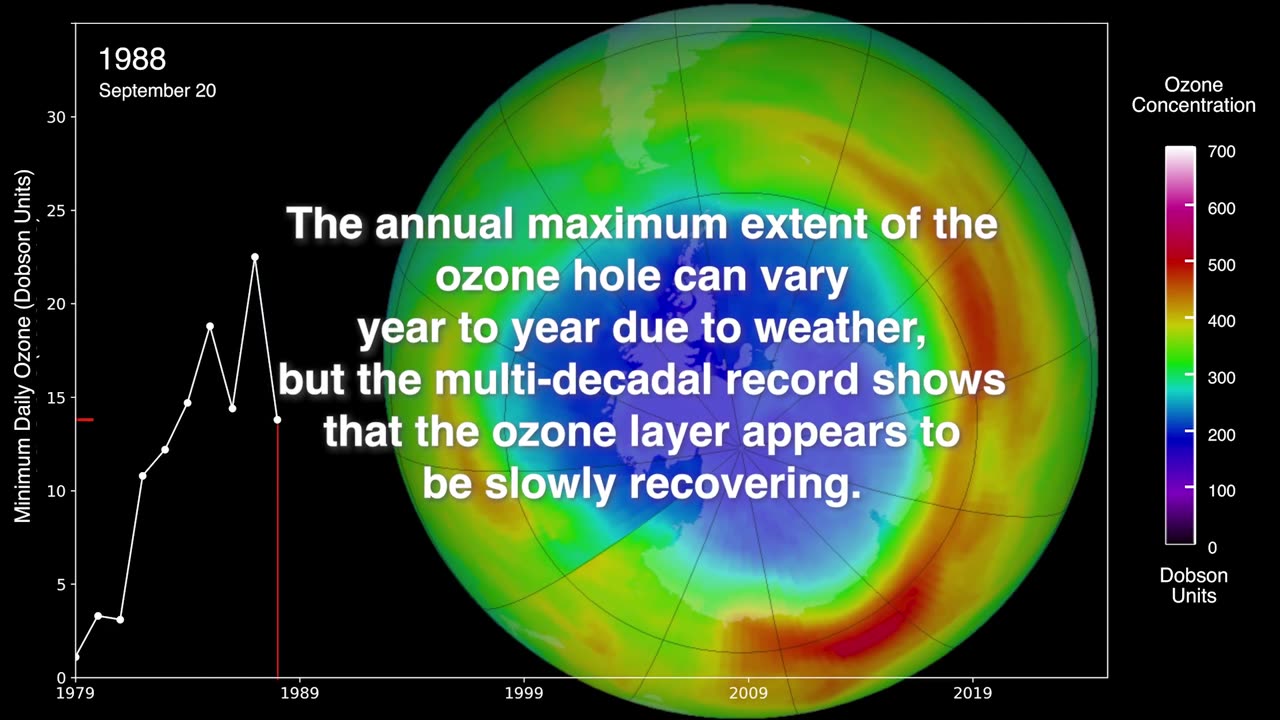Premium Only Content

NASA, NOAA 2024 Ozone Hole Update
This year, the ozone hole over Antarctica reached its annual maximum extent on September 28th, 2024, with an area of 8.5 million square miles (22.4 square million kilometers.)
The hole, which is actually a region of depleted ozone, was the 20th smallest since scientists began recording the ozone hole in 1979. The average size of the ozone hole between September and October this year was the 7th-smallest since the Montreal Protocol began to take effect.
Universal Music Production: “What Was Reported As Is”
Credit: NASA's Goddard Space Flight Center
Kathleen Gaeta (GSFC AMA): Lead Producer
Paul Newman (NASA GSFC): Lead Scientist
Amy Moran (NASA GSFC): Lead Visualizer
James Riordon (NASA GSFC): Writer
This video can be freely shared and downloaded at https://svs.gsfc.nasa.gov/14711 . While the video in its entirety can be shared without permission, the music and some individual imagery may have been obtained through permission and may not be excised or remixed in other products. For more information on NASA’s media guidelines, visit https://nasa.gov/multimedia/guidelines.
Transcript:
0:00
This year, the ozone hole over Antarctica reached its annual maximum extent on September 28th, 2024,
0:04
With an area of 8.5 million square miles (22.4 square million kilometers).
0:08
0:12
0:16
The hole, which is actually a region of depleted ozone, was the 20th smallest since scientists began recording the ozone hole in 1979.
0:20
0:24
The average size of the ozone hole between September and October this year was the 7th-smallest since the Montreal Protocol began to take effect.
0:28
0:32
The annual maximum extent of the ozone hole can vary year to year due to weather, but the multi-decadal record shows that the ozone layer appears to be slowly recovering.
0:36
0:40
“The weakening we’ve seen in the last two decades shows that international efforts that curbed ozone-destroying chemicals are working.” -Paul Newman, Chief Scientist for Earth Sciences at NASA Goddard
0:44
0:48
NASA and NOAA researchers continue to observe ozone through instruments aboard NASA’s Aura satellite, NOAA-20 satellites, and a joint NASA and NOAA satellite called Suomi-NPP.
0:52
0:56
NASA
-
 9:25
9:25
MattMorseTV
1 day ago $4.86 earnedSupreme Court just DROPPED a NUKE.
8.97K38 -
 13:25
13:25
Nikko Ortiz
1 day agoWorst Karen TikTok Fails
4.55K4 -
 40:24
40:24
The Connect: With Johnny Mitchell
2 days ago $17.41 earnedInside The WORST Drug-Infested Slums Of Medellin, Colombia
53.9K27 -
 4:14
4:14
GritsGG
12 hours ago2 Warzone Easter Eggs! How to Find Them EASILY!
994 -
 LIVE
LIVE
Lofi Girl
2 years agoSynthwave Radio 🌌 - beats to chill/game to
158 watching -
 1:45:43
1:45:43
Man in America
12 hours agoThe DISTURBING Truth About Parasites — Live Q&A w/ Dr. Jason Dean
66.5K37 -
 7:13:47
7:13:47
SpartakusLIVE
8 hours ago#1 Mountain of Muscle with HUGE Legs saves your weekend from complete BOREDOMNight HYPE
36.7K1 -
 47:42
47:42
Sarah Westall
9 hours agoFreedom or Slavery? AI will Change Everything w/ Trump Senior Advisor Marc Beckman
52.2K9 -
 2:23:20
2:23:20
vivafrei
16 hours agoEp. 285: Visa Revocation No-Go! Sortor Arrested! Ostrich Crisis! 2A Win! Comey Defense & MORE!
111K101 -
 5:55:11
5:55:11
CassaiyanGaming
6 hours ago🟢LIVE - VISITING GOOB LAGOON! - Will They Rip Me Off?!? Waterpark Simulator
39.4K3
